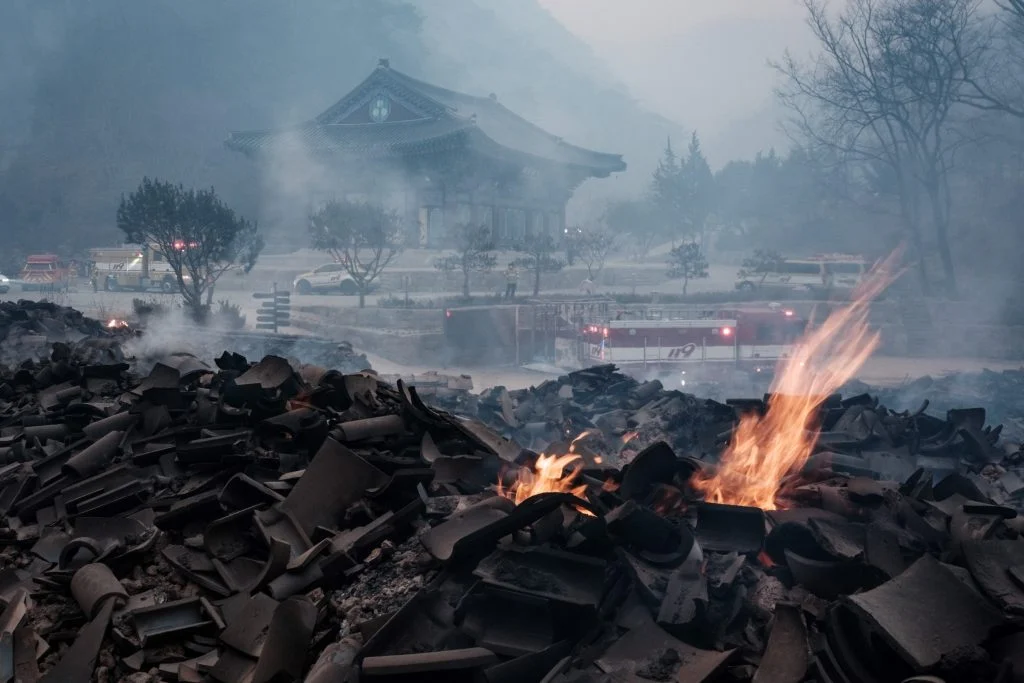South Korea is reeling from one of the deadliest wildfire disasters in its history, with two dozen lives lost, more than 300 structures destroyed, and nearly 30,000 residents forced to evacuate. Among the widespread devastation caused by the flames is the tragic destruction of the Gounsa Temple complex in Uiseong County, an ancient Buddhist site that has stood for over 1,300 years and holds immense cultural and historical significance.
Catastrophic Impact Across the Country
The wildfires, which began on the eastern coast of the country, quickly spread due to dry conditions and strong winds, engulfing multiple regions. Authorities reported that fires have ravaged homes, businesses, and public infrastructure, with thousands of residents displaced and seeking temporary refuge. Officials declared a state of emergency as firefighters, aided by military personnel and volunteers, struggled to contain the advancing inferno.
Destruction of the Gounsa Temple Complex
One of the most heartbreaking losses in the wake of the wildfires is the destruction of the Gounsa Temple complex, a revered Buddhist site that dates back to the 7th century during the Silla Dynasty. Gounsa, which means “Temple of Solitary Cloud,” is located on the slopes of Mount Deungun in Uiseong County’s Danchon-myeon region. The temple complex consisted of over 30 historic structures, many of which were adorned with traditional wooden architecture, intricate paintings, and ornate carvings that reflected Korea’s rich spiritual and artistic heritage.
Conflicting Reports on the Extent of Damage
Reports vary on the full extent of the damage to the temple complex. According to Korea JoongAng Daily, all 30 structures at Gounsa were reduced to ashes, while the Associated Press (AP) reported that around 20 buildings had burned, including historically significant structures such as:
- Gaunru Pavilion – Built in 1668, this historic pavilion offered a scenic view over the stream that flowed through the temple grounds and was a significant landmark in Korean temple architecture.
- Yeonsujeon Hall – Constructed in 1904 to commemorate the longevity of a king, this structure was considered a symbol of honor and reverence in Korean culture.
Both structures, along with many others, had been designated national treasures by South Korea’s Cultural Heritage Administration (CHA) due to their exceptional historical and architectural importance.
Efforts to Save Cultural Relics
Despite the chaos caused by the advancing flames, officials from the Korea Heritage Service managed to rescue several precious cultural relics from the burning temple. Among the items saved was an 8th-century stone statue of Buddha, which had been designated a national treasure due to its artistic and religious value. Other valuable items were moved to safety as part of an emergency operation led by cultural preservation authorities.
While the exact number of artifacts saved remains unclear, officials have emphasized that the preservation of even a fraction of these priceless cultural items is a testament to the quick action taken by emergency teams.
Historic and Cultural Loss Beyond Repair
The loss of the Gounsa Temple complex is being described as irreparable by historians and cultural experts. As one of Korea’s most revered Buddhist sites, Gounsa served as a place of worship, meditation, and reflection for centuries. The destruction of its intricate wooden structures and hand-painted murals means the loss of not just physical structures but also centuries of Korean cultural and religious heritage.
“The destruction of Gounsa is not just a loss for Korea but for humanity,” said a spokesperson for the Korea Heritage Service. “These structures were not merely buildings—they were living testaments to the artistic and spiritual achievements of ancient Korea.”
Impact on Communities and Local Economy
The devastation caused by the wildfires extends beyond the cultural sphere. Thousands of families have been displaced from their homes, while entire communities face the daunting task of rebuilding their lives. The affected regions, many of which rely on tourism linked to their cultural landmarks, now face an uncertain economic future.
Local residents expressed a deep sense of sorrow over the loss of Gounsa, which served as a focal point for community gatherings, religious festivals, and educational activities. The temple attracted thousands of visitors annually, contributing to the local economy and fostering a sense of identity and pride among residents.
Government Response and Recovery Efforts
The South Korean government has pledged swift action to address the immediate needs of those affected by the wildfires while initiating plans for long-term recovery. Emergency relief efforts have been mobilized to provide food, shelter, and medical assistance to displaced residents. Additionally, a task force has been established to assess the full extent of the damage and develop a strategy for rebuilding the affected areas.
Authorities have also committed to exploring possibilities for restoring the Gounsa Temple complex, though experts acknowledge that fully replicating its ancient structures and artistry will be a formidable challenge. Restoration efforts, if undertaken, would likely require years of meticulous craftsmanship and collaboration with skilled artisans.
Calls for Greater Preparedness and Preservation Measures
The tragedy has sparked renewed calls for greater preparedness in protecting South Korea’s cultural heritage sites from natural disasters. Experts have emphasized the need for fire-resistant materials in vulnerable structures and the implementation of advanced fire detection and suppression systems at historic sites.
Preservationists are also advocating for the digitization of cultural treasures through 3D scanning and imaging technologies, which can help document and preserve intricate details of heritage sites for future restoration efforts.
A Moment of National Mourning
As South Korea mourns the loss of lives, homes, and cultural treasures, the nation is grappling with the enormity of the disaster. The destruction of Gounsa Temple serves as a stark reminder of the fragile nature of cultural heritage in the face of natural calamities. Moving forward, the tragedy underscores the urgent need for enhanced measures to protect and preserve the invaluable legacy of Korea’s past for future generations.



0 Comments